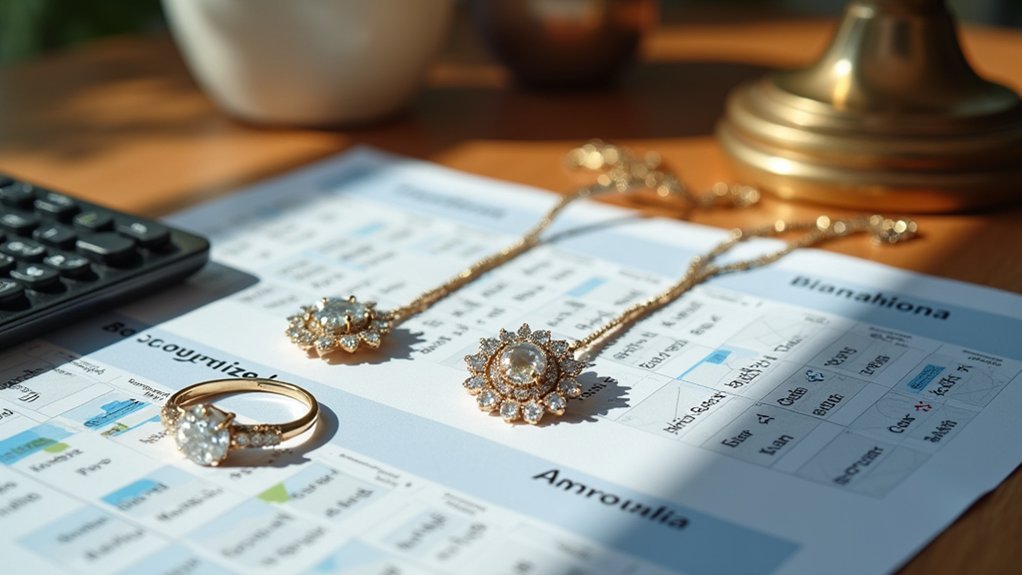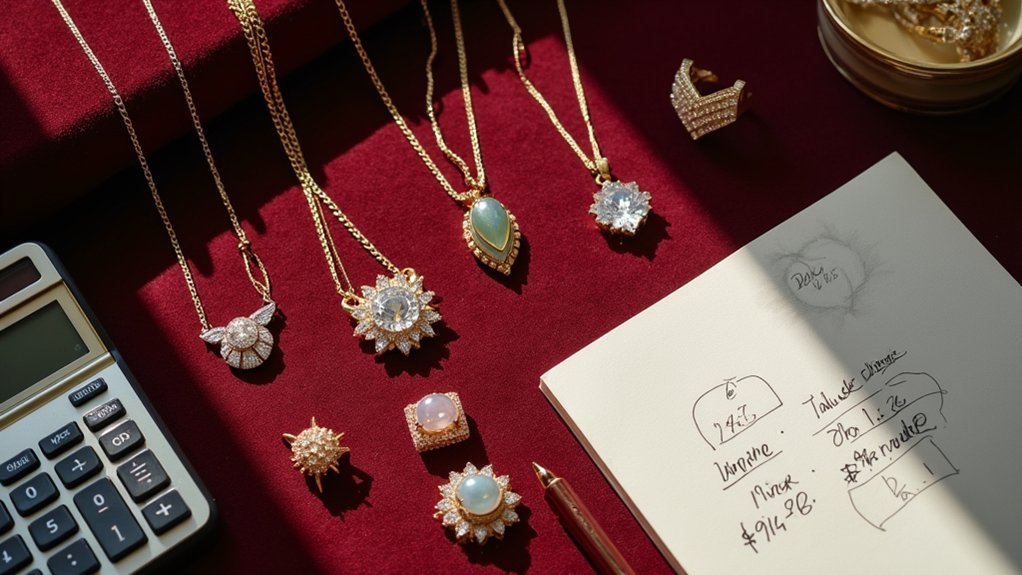To set profitable wholesale prices, you’ll need to calculate your complete cost of goods sold including materials, labor, overhead, and equipment depreciation. Start with keystone pricing (100% markup) as your foundation, then aim for profit margins between 30-50% for sustainable growth. Research competitor pricing to guarantee market competitiveness while implementing tiered volume discounts to encourage larger orders. Factor in seasonal demand fluctuations and communicate any price changes transparently to maintain strong customer relationships—mastering these fundamentals will transform your pricing strategy.
Understanding Jewelry Wholesale Pricing Fundamentals

When you’re entering the jewelry wholesale market, establishing the right pricing foundation starts with calculating your cost of goods sold (COGS), which includes materials, labor, and overhead expenses.
You’ll need effective wholesale pricing strategies that balance profitability with competitive pricing. Start with a 100% markup percentage—known as keystone pricing—then adjust based on perceived value and market positioning.
Your profit margins should typically range from 30% to 50% for sustainable growth.
Monitor market trends and seasonal trends closely, as they directly impact demand and pricing opportunities.
Successful inventory management requires understanding how these fluctuations affect your wholesale rates.
Calculating Your Jewelry Production Costs
You’ll need to accurately track your material and labor costs to establish a solid foundation for wholesale pricing.
Equipment depreciation and overhead expenses must be factored into each piece you create, ensuring you’re not undervaluing your work.
Don’t overlook quality control investment, as it’s essential for maintaining standards that justify your wholesale rates.
Material and Labor Costs
The foundation of accurate wholesale pricing begins with calculating your Cost of Goods Sold (COGS), which combines raw material expenses and direct labor costs for each jewelry piece.
You’ll need to track every component, from gemstones and precious metals to the time skilled artisans spend crafting each item.
To determine your total cost accurately, follow these essential steps:
- Calculate material costs by tracking current supplier pricing for all raw materials and components.
- Document labor costs by recording actual time spent on each production stage at market wage rates.
- Apply absorption pricing to allocate fixed and variable costs like utilities and rent proportional to your production space.
Monitor production efficiency regularly to identify waste and streamline processes.
This thorough approach to understanding the cost of a product guarantees effective pricing that maintains competitiveness while protecting profitability.
Equipment and Overhead Expenses
Beyond material and labor costs, equipment and overhead expenses form the hidden backbone of your jewelry production costs that can make or break your wholesale pricing strategy.
Equipment costs range from basic hand tools costing hundreds to specialized machinery exceeding thousands of dollars. You must factor these into your pricing calculations to maintain profitability.
Overhead expenses include rent, utilities, and equipment depreciation that considerably impact your operational expenses. To establish competitive pricing, you’ll need to account for both fixed and variable overheads in your cost analysis.
Regularly reviewing market rates and monitoring these expenses helps you adjust prices strategically. Without thorough tracking of all production costs, you risk underpricing your wholesale jewelry and compromising long-term business sustainability.
Quality Control Investment
Quality control investment represents one of your most impactful production cost decisions, directly affecting both your immediate expenses and long-term profitability.
While these overhead costs might seem substantial upfront, they’re essential for maintaining competitive pricing and meeting customer demand in today’s market.
Key Quality Control Investment Areas:
- Inspection Equipment and Training – Advanced tools and skilled personnel to catch defects before they reach customers, reducing costly returns that damage your wholesale pricing structure.
- Testing Materials and Processes – Regular verification of gold purity, gemstone authenticity, and craftsmanship standards to maintain reputation and avoid inventory management nightmares.
- Documentation Systems – Tracking quality metrics helps you adjust production costs based on market trends while ensuring consistent output that supports sustainable profitability across your wholesale operations.
Determining Optimal Profit Margins for Jewelry Wholesale
Establishing profit margins between 30% and 50% positions your jewelry wholesale business for sustainable growth while keeping prices competitive in today’s market.
Profit margins of 30-50% create the sweet spot for jewelry wholesale success and market competitiveness.
You’ll want to implement keystone pricing as your foundation wholesale pricing strategy, doubling your cost of goods sold to achieve healthy margins. While retail markup can reach 100% to 300% depending on materials and craftsmanship, your wholesale profit margin must account for additional expenses like shipping, marketing, and overhead costs.
Monitor market trends and competitor pricing regularly to refine your pricing strategies. This analysis helps you respond effectively to consumer demand while maintaining profitability.
Remember that sustainable jewelry wholesale success depends on balancing competitive rates with margins that support long-term business growth and operational expenses.
Researching Competitor Pricing in the Jewelry Market

Since competitor pricing directly impacts your wholesale strategy’s success, you’ll need to conduct thorough market research to understand how other jewelry wholesalers position their products.
Analyzing competitors’ pricing reveals market standards and helps you set profitable wholesale prices that remain competitive.
Key Research Areas for Jewelry Wholesale Pricing:
- Markup Analysis – Study how competitors price between wholesale prices and retail prices, noting that fine jewelry typically sees 100%+ markups while fashion jewelry ranges 60-80%.
- Tiered Pricing Structures – Examine volume-based pricing strategies competitors use to encourage larger orders and build customer loyalty.
- Promotional Patterns – Monitor seasonal discounts and special pricing events to understand consumer demand cycles and market expectations.
Effective pricing involves balancing profit margins with competitive positioning while responding to market trends that drive consumer purchasing decisions.
Implementing Tiered Pricing Strategies for Different Order Volumes
You’ll maximize your wholesale revenue by creating volume discount structures that reward larger orders while protecting your profit margins.
Start by establishing clear price breakpoints at strategic order volumes—like 50, 100, and 250 pieces—where customers gain access to progressively better pricing tiers.
This approach encourages bigger purchases while ensuring you maintain healthy margins at each tier level.
Volume Discount Structures
When you implement tiered pricing structures, you’ll create a powerful incentive system that encourages customers to purchase larger quantities while boosting your average order value.
Volume discounts transform customer purchasing patterns by making larger orders more attractive through progressive savings.
Here’s how to structure effective volume discounts:
- Create clear discount tiers – Offer 5% for 100 units, 10% for 250 units, and 15% for 500 units to encourage incremental increases.
- Set strategic minimum order quantities – Establish MOQs that guarantee profitable transactions while maintaining competitive pricing.
- Monitor and adjust regularly – Analyze sales data to refine your tiered pricing structures based on actual customer behavior.
This approach helps clear excess inventory, improves cash flow through immediate bulk purchases, and guarantees your pricing remains both competitive and profitable.
Price Breakpoint Determination
Determining the ideal price breakpoints for your tiered structure requires careful analysis of customer purchasing behaviors and profit margins.
You’ll need to examine your sales data to identify natural ordering patterns and set competitive thresholds that encourage larger purchases. Start by calculating your cost structure and establishing a minimum order quantity that maintains profitability at each tier.
For effective tiered pricing, consider implementing breakpoints at 100, 500, and 1,000 units with corresponding discounts of 10%, 15%, and 20%. This approach incentivizes wholesale customers to increase order volumes while protecting your margins.
Regularly review these breakpoints against market conditions and competitor pricing to guarantee your structure remains attractive yet profitable across all tiers.
Margin Protection Strategies
Since protecting your profit margins while attracting wholesale customers requires strategic balance, implementing tiered pricing structures becomes crucial for sustainable business growth.
Your wholesale business can leverage tiered pricing to incentivize bulk buyers while maintaining profitability across different order volumes.
Key Tiered Pricing Strategies:
- Structure Volume-Based Discounts – Set progressive price breaks (e.g., $10/unit for 100 units, $9/unit for 500 units, $8/unit for 1,000 units) to encourage larger purchases while safeguarding your profit margin.
- Establish Strategic Minimum Order Quantities – Implement MOQs within each tier to streamline inventory management and guarantee every order contributes positively to profitability.
- Monitor and Adjust Regularly – Review your pricing strategies against market conditions and competitors to maintain your competitive edge while maximizing Average Order Value across customer segments.
Setting Minimum Order Quantities for Profitable Transactions
Although wholesale pricing involves multiple variables, establishing minimum order quantities (MOQs) stands as one of your most powerful tools for ensuring each transaction covers fixed costs and generates meaningful profit.
When setting minimum order quantities, you’ll typically establish ranges from 10 to 100 units depending on your industry and product complexity.
MOQs promote bulk purchasing while helping you reduce costs through improved shipping efficiency and streamlined inventory management. You can enhance your pricing strategies by offering tiered discounts that incentivize larger orders, boosting your overall sales volume and profit margin.
Remember to regularly review your MOQs based on market demand and production costs. This approach maintains your competitive edge while ensuring consistent cash flow and ideal inventory turnover in your wholesale pricing structure.
Creating Value-Based Pricing for Premium Jewelry Lines

While MOQs help establish baseline profitability across all wholesale transactions, premium jewelry lines require a fundamentally different pricing approach that focuses on perceived value rather than cost-plus calculations.
Value-based pricing allows you to position your pieces 30-50% above competitors by emphasizing craftsmanship and exclusivity. Conduct thorough market research to understand customer demographics and their willingness to pay premium pricing that aligns with luxury expectations.
Essential Value-Based Pricing Strategies:
- Highlight unique selling points like ethically sourced materials or bespoke designs to justify 60-80% margins.
- Implement tiered pricing for different collections and limited editions to create urgency and exclusivity.
- Regularly gather customer feedback to refine your value proposition and adjust pricing strategies.
This approach transforms your jewelry from commodity products into coveted luxury items, maximizing profitability while maintaining market competitiveness.
Establishing Seasonal and Promotional Pricing Adjustments
Beyond establishing your premium pricing foundation, you must adapt your wholesale rates to capitalize on predictable market fluctuations throughout the year.
Seasonal pricing allows you to increase costs by 10-20% during peak demand periods like holidays, maximizing profitability when market conditions favor higher rates.
Promotional pricing strategies complement seasonal adjustments by driving sales volume through limited-time discounts and bundle offers.
You’ll boost revenue 15-30% during promotional periods while improving inventory management. Analyze historical sales data to time these campaigns effectively.
Focus on customer engagement by offering exclusive seasonal promotions to loyal buyers—personalized offers increase engagement up to 50%.
Maintain flexibility in your pricing strategies, adjusting rates up to 25% based on competitor analysis and market trends.
Managing Price Changes and Customer Communication

When you implement price changes, effective customer communication becomes the cornerstone of maintaining strong business relationships and preventing order cancellations. Your pricing strategies must include transparent communication protocols that preserve customer relationships while adapting to market trends.
Essential steps for managing price adjustments:
- Communicate price changes 30 days in advance – Give customers time to adjust their purchasing strategies and budget accordingly for your products.
- Explain the reasoning clearly – Detail factors like increased production costs or market conditions driving the necessity for new pricing models.
- Offer alternative pricing structures – Consider tiered pricing or adjusted minimum order quantities to soften impacts on loyal customers while encouraging larger orders.
Regularly review your pricing models based on customer feedback and market trends to maintain competitive positioning.
Monitoring Sales Performance and Adjusting Wholesale Prices
As market conditions shift and customer behaviors evolve, monitoring sales performance becomes vital for maintaining profitable wholesale pricing strategies. You’ll need to analyze sales data regularly to identify trends in customer purchasing behavior and adjust your approach accordingly.
Track key performance indicators like revenue per product, units sold, and gross profit margins. Implement dynamic pricing models that respond to real-time market conditions, competitor pricing, and inventory levels. Don’t overlook customer feedback—it reveals significant insights about pricing perception and value alignment.
| Performance Indicator | Action Required |
|---|---|
| Declining profit margins | Reassess pricing structure |
| Slow inventory turnover | Consider price adjustments |
| Customer price complaints | Evaluate value proposition |
| Competitor underpricing | Review competitive positioning |
Use A/B testing on select products to determine which wholesale pricing strategies deliver ideal results.
Frequently Asked Questions
What Is the Best Pricing Strategy for Wholesale?
You’ll want to use cost-plus pricing with 30-50% markup as your foundation. Add tiered discounts for bulk orders and set minimum order quantities to guarantee profitability while staying competitive.
What Is the Rule of Thumb for Wholesale Pricing?
You’ll typically set wholesale prices at about 50% of retail price. This rule of thumb guarantees you’re covering costs while giving retailers enough margin to profit when they sell to consumers.
How Do You Set Prices to Make Profit?
You’ll calculate your total costs including production, shipping, and overhead, then apply a markup strategy like doubling COGS for retail or maintaining 15-50% wholesale margins based on market conditions.
What Is the Wholesale Price Rule?
You’ll set wholesale prices at roughly 50% of retail prices. This pricing strategy guarantees you’re covering production costs while giving retailers enough margin to cover their operational expenses and make profit.
In Summary
You’ve now got the framework to set profitable wholesale jewelry prices that work for your business. Remember to regularly review your costs, monitor competitor activity, and track your sales performance. Don’t be afraid to adjust your pricing as market conditions change. By implementing these strategies consistently and maintaining open communication with your customers, you’ll build a sustainable wholesale pricing structure that maximizes profitability while keeping clients satisfied.





Leave a Reply